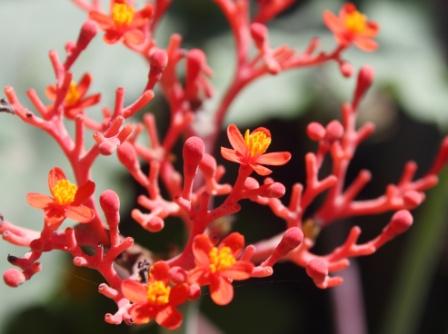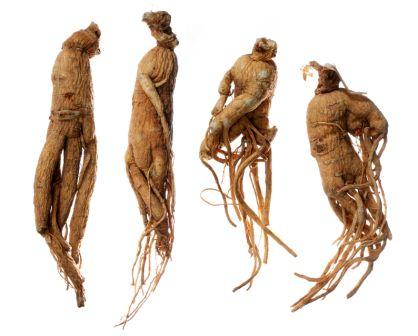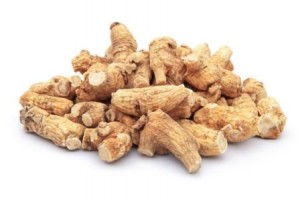
Latin Name
- Chinese; Korean; Asian – panax ginseng C.A. Meyer; panax notoginseng.
- American – panax quinquefolius.
- Siberian – eleutherococcus senticoccus acanthopanax.
Common Name
Ginseng; Chinese Ginseng; Asian Ginseng; Ren Shen (Man’s Root – the Chinese see a man’s body in root form); Five Fingers (because of its five leaflets); Man’s Health; Man’s Plant; Red Berry; “The King of Tonics”; “The Wonder of the World”; Tartar Root; Schin-Seng; San Qi.
Folklore
Traditional Chinese folklore tells the story of an old hunter who had two sons. The two sons had just learnt how to hunt for themselves and were eager to put their training into practice. The old hunter advised them to wait until winter was over, but the two sons were impatient, and left for the mountains to see what they could find.
Luck was on their side and they managed to hunt quite a number of animals within a few days. However, the weather suddenly changed into snow which blocked most of the passages out of the mountain and the two brothers found themselves trapped with limited food available.
A week had passed and the search for food was getting desperate until the two brothers came across a plant that looked very different from the others. After digging it out, they were surprised to see it resembled a man standing up. They began to eat the sweet yet bitter roots and after a few days, they discovered it gave them more energy.
As they were still in the bitterly, cold winter, they understood they would need more energy to last so began eating the root in large doses. However, one of the brothers began to have severe nosebleeds, so they moderated their intake of the root. They managed to survive the winter on the roots of the plant, and when the snow had finally melted, the two brothers headed home.
The old man was overjoyed and relieved of their return yet troubled at how his two sons could have survived the cold winter. He and the entire village thought they had died. When he asked his sons, one them said “We ate the roots of a plant, we do not know the name of it but its roots look like a man”. The old man responded, “Ah….it must be man’s plant”.
Botanical Name
panax ginseng; panax quinquefolium; aralia quinquefolia; radix ginseng; radix panacis quinquefolii.
Description

Ginseng belongs to the genus panax of the araliaceae family and is indigenous to certain cool climate areas of China, eastern Asia and North America. It is a slow-growing perennial plant that can grow up to 2ft tall. The leaves (around 3-5 on each stem) form at opposites of the stem with each leaf divided into five leaflets with jagged edges.
The flowers produced are yellow-green in colour that bloom in opposites, with a crown of one top bloom, followed by clusters of shiny, bright red berries. Ginseng’s root grows slowly and often takes around three years to reach maturity. The fleshy, parsnip-like roots take the form and shape of a man’s body (hence the name Man’s Root) and the colours vary from cream, light yellow and brown (dependent on which type).
The Asian and American Ginseng differ only slightly in appearance.
Origin
Native to certain areas of China, eastern Asia and North America. Cultivated in China, Japan and Korea.
Parts Used
The root – which contains volatile oils; steroidal glycosides; saponins; acetyleneic compounds; sterols; resin; pectin; starch.
Flavor
Sweet and slightly bitter.
Brief History
Ginseng has been widely used in China for over 5000 years and still continues today. The generic name ‘panax’ is derived from the Greek word for ‘panacea’ meaning “all-healing”. The name also means “The Wonder of the World” and the Chinese consider this herb a supreme remedy for all diseases – it was such an important herb that in the past, the roots were solely collected and used by the emperor of China!
For many centuries, it was used to calm nerves, strengthen organs, increase mental ability, stop heart palpitations, brighten vision and in providing a youthful feeling.
It was well known to the Arab physicians in the 9th century. Marco Polo wrote about this prized wonder herb and when Louis XIV received this herb as a gift form the King of Siam – it exclusively became a popular tonic for rich Europeans, who used it to treat exhaustion and debility.
By the 18th century, it had become widely used in America as it was discovered to be indigenous – and was used to treat loss of appetite, stomach and digestive problems and nervous and mental exhaustion.
Medicinal Uses & Properties
* Stimulant
Ginseng is considered to work well against fatigue as it acts on the pituitary and adrenal glands and stimulates your nervous system in order to decrease fatigue. Some advocates of Ginseng believe it can enhance athletic performances. It has also been used to increase heart contractions and help tone the heart, thus it is beneficial in treating heart failure and shock.
* Anti-depressant
Ginseng is sometimes known as an “adaptogen”- which is a herb that balances ‘opposites’ and helps the body to defend itself from various forms of stress. It has been shown to balance the release of stress hormones and support the organs that produce them (the pituitary glands, the hypothalamus and the adrenal glands).
* Regulator of Blood and Cholesterol Levels
It raises HDL (good cholesterol) levels and has the ability to stabilize and regulate blood sugar levels. Some studies have shown that taking American Ginseng actually lowered the blood sugar levels in people with Type 2 Diabetes. Ginseng can help in stimulating red and white blood cells in order for your body to better defend itself against disease.
* Impotence

Ginseng has long been used to boost male virility as it can improve the blood flow to the penis. It can increase hormone secretions in the endocrine system (complex network of glands and hormones that regulates many of the body’s functions such as growth and development) and can be used as tonic for the libido, to help fight impotence and frigidity.
* Anesthetic
Ginseng has been used as a first-aid treatment to stop internal and external bleeding. During the Vietnam War, it was used extensively by the North Vietnamese to speed up the recovery rates from gun shot wounds.
Other Uses
* Ginseng has also been widely used to improve and increase brain functions in addition to enhancing the memory.
* The Chinese believe it can increase your life expectancy and help you feel youthful. Because of this factor, many Chinese believe it is wasted on the young and is best used for those of a maturer age. The root is chewed to increase vitality, treat cancer tumors and lung disorders and prolong life.
* Can be used to improve the functions of digestion, absorption and metabolism.
* The health benefits of Ginseng has spread to many facets of human consumption- such as in cooking, in soft-drinks, in chewing-gum and sweets, in honey and even in wine. This is due to its high levels of vitamins and minerals, that include – Vitamin B1; Vitamin B; Vitamin B12; Vitamin D; Iron; Calcium; Magnesium; Manganese; Copper; Zinc and Vanadium.
* Ginseng also contains anti-oxidant properties which has been used to prevent cellular aging and improve skin tone.
Prepared As
decoction; tincture; powder (in capsules or tablet form).

Possible Side Effects
* People who suffer from high blood pressure, narcolepsy (frequent and uncontrollable deep sleep) or taking blood thinning drugs should avoid taking Ginseng.
* Pregnant women are advised to avoid Ginseng as it could adversely affect the fetus.
* Those taking anti-depressants should avoid this herb as it could induce mania.
* Korean Ginseng has a ‘warm’ action – those who have inflammatory conditions, fever or swelling are advised not to take this as it could increase heat in the body which could intensify the condition.
* As it is a stimulant, Ginseng shouldn’t be taken alongside any other herbal stimulants such as Ephedra, or with other stimulants that contain caffeine such as coffee, tea, cola drinks.
* In high doses, Ginseng may cause insomnia, headaches, nose bleeds, nervousness, nausea and diarrhea.
* It is not recommended for those taking medication for diabetes as it can lower blood sugar levels and interact with the effectiveness of the drug.
————————————————————————————————————————
This website is for educational and informational purposes only. The publisher/owner of blendingherbaltea.com is not legally liable for your use of the information which is not intended to diagnose, treat, cure or prevent any disease. If you have any serious health concerns, you should always check with your health care practitioner or medical herbalist before self-administering herbs.

Hi Teresa
A really nice and informative site. Ive never been a tea drinker (more of a coffee head) as I just thought tea came from a bag with PG tips on the box but i love some of the ideas that you have shared. You have certainly opened my eyes and I shall definitely be trying some of your suggested blends.
Thank you for sharing. I very much enjoyed visiting your site.
Hi Andy
thanks for your positive vibes. Yes, there is so much to tea than teabags! Don’t get me wrong, I’m still a big fan of coffee too – just love the taste and aroma:0) – but drinking 2-3 cups a day isn’t too good for you. Whereas drinking 2-3 cups of herbal tea is not only refreshing but can be medicinal too. You get the highs without the lows!
I hope you will visit soon and let me know of your herbal tea adventures!
Great post, Teresa.
I love the story about the two boys on the mountain.
I am becoming more fascinated with Herbal and Natural Medicine with each new article I read.
Many modern cures and medicines have their background in traditional herbs, roots, and remedies.
The fact that ginseng has been used for over 5000 years is a testament to its healing powers and health benefits.
Does the “age” of the ginseng root affect its potency?
Are there very different potency values between the ginseng grown in the various locations?
Thanks. Paul
Hi Paul
these are great questions! – Both age and location are important factors when grading Ginseng. It is typically a slow-growing plant and the older plants are generally more medically potent and more expensive too. Wild Ginseng is the most sought after due to its potency and character as the harvested roots are usually older.
Hope that answers your questions.
I really enjoyed learning the story behind ginseng. It does look like a man. I have never seen the (above ground) ginseng plant, so I found the information on this really interesting. One may even have to have a license go grow this in the US? What a fascinating root! thanks so much for this lesson.
Thanks for your positive vibes Lisa. I agree, this is an incredibly fascinating root and I just love the fact that it resembles a scary-looking man!
This is very interesting. Thanks.
Thanks Mark.
Thanks for a very informative article. I used to regularly take ginseng but when I began to wean myself from supplements ginseng kinda got left behind. I know that it is a natural product and marketed as a supplement, but do you know if it is difficult to grow?
I remember seeing fields of it by the highway driving through British Columbia in warmer parts where they had netting, I believe, as a sun shield.
Thanks for stopping by Jim!….I understand your weaning from synthetic supplements due to their very nature that they aren’t natural. Supplements for Ginseng have become more widespread due to their convenience yet they can still be bought in root form.
Personally, due to time and space, I haven’t been able to grow my own herbs although it is something I would love to do. From my research, growing Ginseng is only for the patient and committed gardener due to the fact it is a slow- growing plant – they can take between 5-10 years to harvest!
Ginseng prefers plenty of shade in order to thrive – and those that have tried growing have used the ‘wild-simulated method’ which mimics the natural growing environment for it. However, problems that occur from this method are the crops could be eaten by rodents or even stolen (due to its high value). I believe in some American states, you would need a licence to harvest and sell the plant as it is an becoming an endangered species.
It would be interesting to know if you decide to undertake this arduous task!
Wow, that is a long time to harvest. I guess I will have to do a bit of research as I am really expanding my gardens. I put in a cold frame last year and I have kale and Mizuna lettuce that survived a Canadian winter!
Good for you! It’ll be good to know of your research findings.
More great info, Teresa. I had no idea of ginseng’s legend and many benefits. Fights impotence and frigidity, eh? Sounds like my cup of tea.
Hi Bill, I was aware Ginseng had many beneficial properties as my mum used to make (and still does) what we call in our culture ‘beneficial soups’ – and Ginseng was always used mainly as it enhanced brain power and helped regulate blood sugar levels. I was pleasantly surprised of the many other benefits whist researching this incredible herb! Thanks for stopping by.